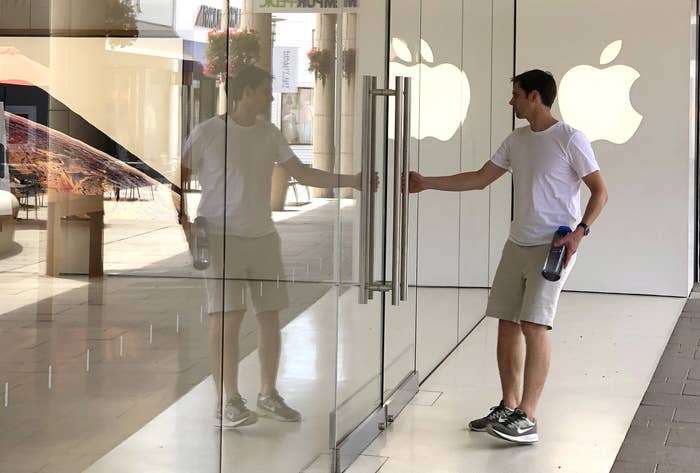
When Apple opened its first store in 2001, it seemed destined to fail. Bloomberg Businessweek said, “Sorry, Steve: Here’s Why Apple Stores Won’t Work.” David Goldstein, former president of the consulting firm Channel Marketing, said, “Apple will turn the lights off within two years and will have a very bad and expensive experience.” And the New York Times piled on, “no computer manufacturer has successfully branched into retail stores.”
We all know what happened next — Apple changed the retail game.
The company faces the same challenge with its stores as it does with its products — how to keep pace once its cutting-edge ideas have become standard.
Apple Stores, which now number 508 across 22 countries, broke every rule in electronics retailing on its way to becoming a cultural icon. Instead of the food court, it was a meet-up spot for friends before window-shopping at Hot Topic or Claire’s. People spent hours in its sleek stores hovering over the rows of Mac laptops playing with the filters on Photo Booth and uploading the best photos to Myspace. It felt like stealing when an Apple Store employee would swipe your credit card on an iPhone instead of waiting in line at a register. When they’d operate on your glitchy computer and hand it back to you shiny and new, the people at the Genius Bar seemed like actual geniuses. It was an experience that other computer retailers like Dell and Microsoft tried to imitate but couldn’t. It was the future — and then the future caught up.
Now nearly 20 years later, and a week away from the grand reopening of Apple’s Fifth Avenue flagship store in New York, the company faces the same challenge with its stores as it does with its products — how to keep pace once its cutting-edge ideas have become standard.
“Now more than ever retailers are depending on experience to drive traffic,” Mike Smith, director of real estate with the business consulting firm Streetsense, told BuzzFeed News. “Apple was a bit ahead of the curve with everyone else playing catch up. But it also makes Apple seem less special and less innovative.”
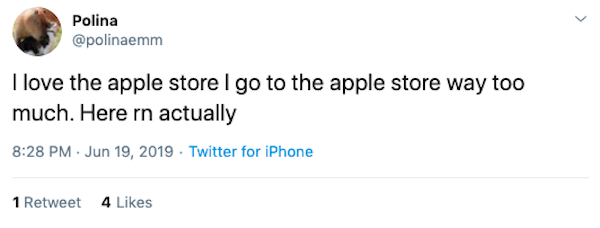
Apple is keeping mum about the details of its new Fifth Avenue store, slated to reopen Sept. 20 after being closed for two years. It declined to provide additional comment to BuzzFeed News. But Deirdre O’Brien, Apple’s new director of retail (who took over the company’s retail fleet after Angela Ahrendts left the company in April) said at Apple’s annual keynote event Tuesday that the store’s iconic glass cube will be wrapped in a multicolor film. It will be open 24 hours a day and will host training sessions for Apple users and stations for shoppers to customize their Apple Watch bands. But other than higher ceilings, increased size, and the rainbow cube, it appears very little about the New York store will be new.
The opening of its flagship store comes in a period of accelerated innovation in retail and technology — and heightened competition. Thanks to Amazon, consumers expect affordable items at their doorsteps within one or two days, an expectation that has created havoc on city streets. People are amazed by its Amazon Go cashierless checkout technology, which allows customers to grab an item off a shelf and walk out without paying for it at a register.
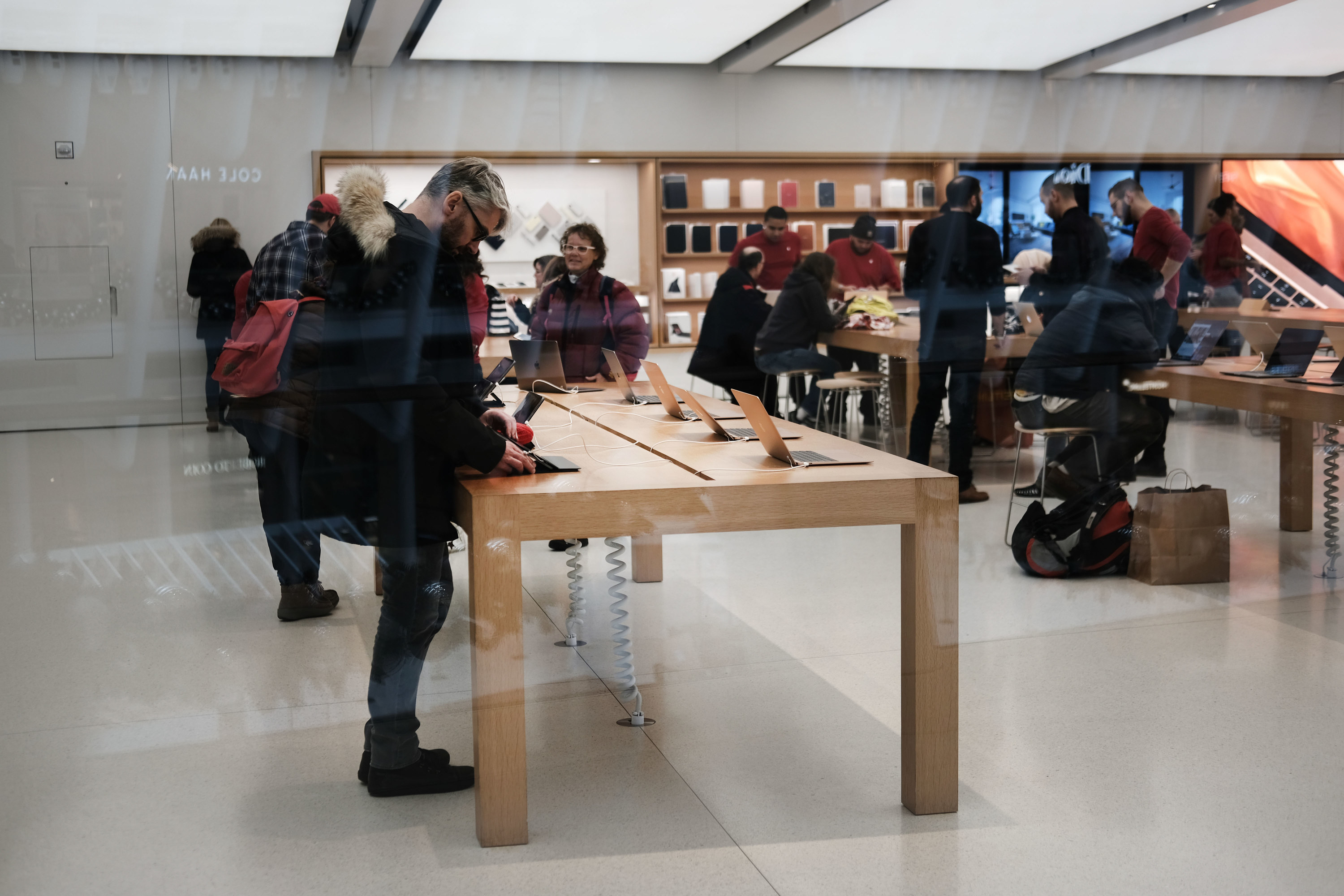
Retail industry insiders point to Glossier’s new store in New York’s Soho neighborhood as an example of how to make a retail store an experience for shoppers at a time when not all businesses can be, or want to be, an Amazon. It has nearly its entire makeup line out for testing. Its design is minimal and clean with multiple areas where shoppers can stop to take selfies. It isn’t alone. Mattress company Casper’s new stores incorporate experience in their design as well with multiple sleep pods where shoppers are invited to take a nap during the day or sleep in small rooms on the showroom floor. Casper also has an area where shoppers can learn about the technologies that go into its products. Sephora, an LVMH company, upended the beauty market with stores that leave full makeup collections out for customer testing as makeup artists give tutorials and tips.
As others have copied its retail approach, Apple has quietly receded from its perch as the leader in retail innovation. In September 2017, Ahrendts announced that Apple Stores would no longer be “stores” but “town squares,” which she described as “gathering places ... where everyone’s welcome, and where all of Apple comes together.” Apple has opened several flagship stores to reflect this idea of stores as “public squares,” including one in Chicago and one in San Francisco. The company launched a program called Apple Today, a series of classes to teach users how to use GarageBand and other software. It redesigned some of its Genius Bars into “Genius Groves” of trees and additional seating to create a more comfortable atmosphere.
But the idea of the Apple Store as a community space never quite took off, and after five years at Apple, Ahrendts left the company. “I think it just didn’t quite click,” said Smith with Streetsense.
Apple has upgraded some of its stores with greenery that gives some stores the feeling that shoppers are in a park, not a computer store. But the result is “largely the same old, same old — product showcases, accessories on the side wall, Genius Bar in the back,” Sucharita Kodali, a retail analyst with Forrester Research, told BuzzFeed News.
“Apple is just mature at this point, and mature brands stagnate.”
“Apple is just mature at this point, and mature brands stagnate,” she said. “Given how frequently customers see the stores, they probably have to refresh every 5 to 10 years, which is faster than most retailers. They need to think of themselves like restaurants or fashion, which are challenged to keep customer attention.”
Most Apple customers don’t buy their phones or laptops in store. In 2017, about three-quarters of iPhones were bought through wireless carrier companies with Apple Stores accounting for just more than 10% of sales, according to Consumer Intelligence Research Partners. Apple was the second-largest retailer of iPads making up about 20% of sales. To get people coming back to its stores, Apple created the trade-in program for customers to exchange an old iPhone for a new one at a discount. But unless they’re running an errand — trading in a phone or getting a device fixed — there is little incentive to go into the Apple Store.
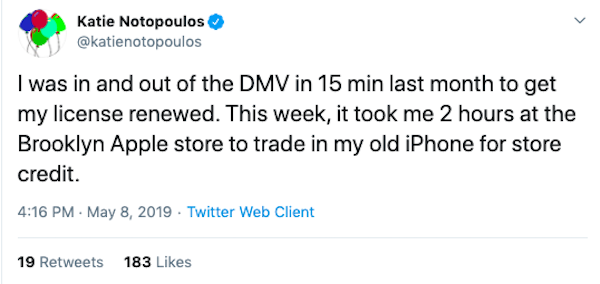
Carolina Milanesi, a principal analyst at the market research firm Creative Strategies, told BuzzFeed News that Apple’s approach to move sales transactions online and turn stores into educational spaces show the retailer is still ahead of the curve. “That is a long-term investment,” she said. “You have consumers that are more engaged with your products because of the value they get from the device they purchase is greater.”
But Apple shoppers have taken notice at the stores’ stagnation. On Twitter, one person said stores used to feel magical and now seem stale and boring. Another noted the Samsung store in Toronto was more impressive than the Apple Store. Apple’s stores are almost always packed with irritable people waiting in line to get help with their phones, leading to comparisons to an airport when your flight is canceled or to waiting at the DMV. Still, the company has a loyal segment of consumers who just really love the Apple Store.
While the stores may no longer be exciting, they’re doing better than most other mall storefronts, analysts told BuzzFeed News. Apple doesn’t regularly report its store sales, but analysis of industry data shows that it is the store leader among retailers in sales per square foot, a metric that the retail real estate industry uses to measure store profitability. A 2017 CoStar analysis of retail industry data found that Apple led retail store sales at $5,546 per square foot, outselling luxury retailer Tiffany & Co., which reported sales of $2,951 per square foot, and athleisure company Lululemon, which reported sales of $1,560 per square foot.
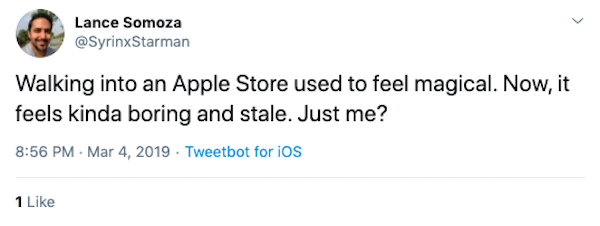
Still, analysts and customers have noticed that Apple Stores have lost their “wow” factor, as other companies like Microsoft and Tesla incorporate the design tactics that made Apple Stores famous into their own stores and showrooms.
“Customers have gotten used to them and have much higher expectations that are increasingly difficult to meet,” Neil Saunders, a retail analyst with GlobalData, told BuzzFeed News. “Apple is still a leader in retail, but there isn’t as much clear blue water between it and competitors.”
